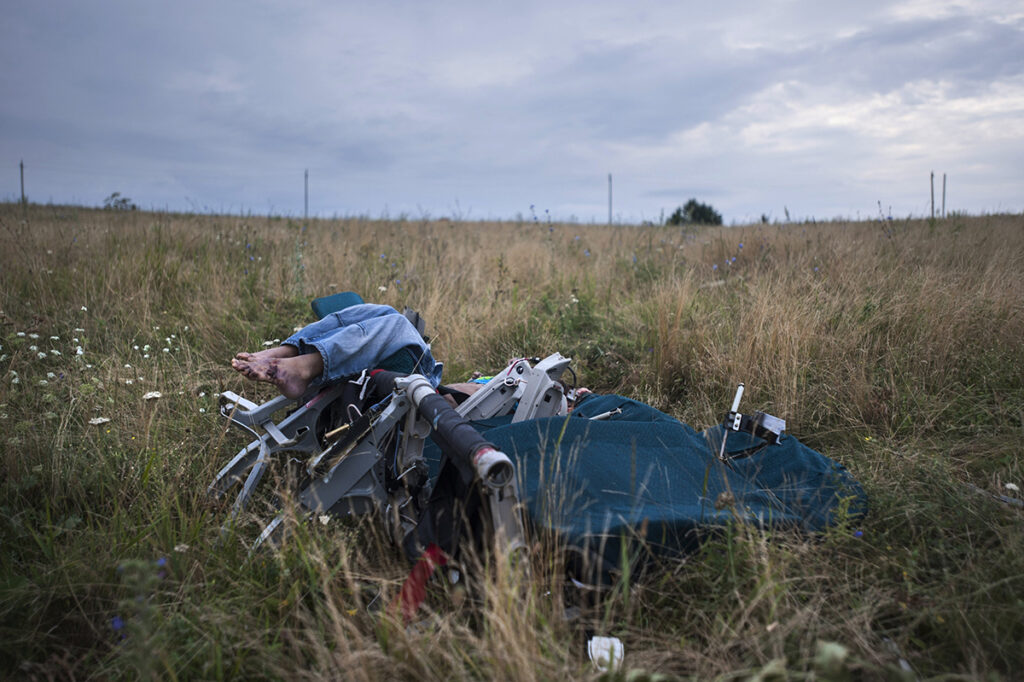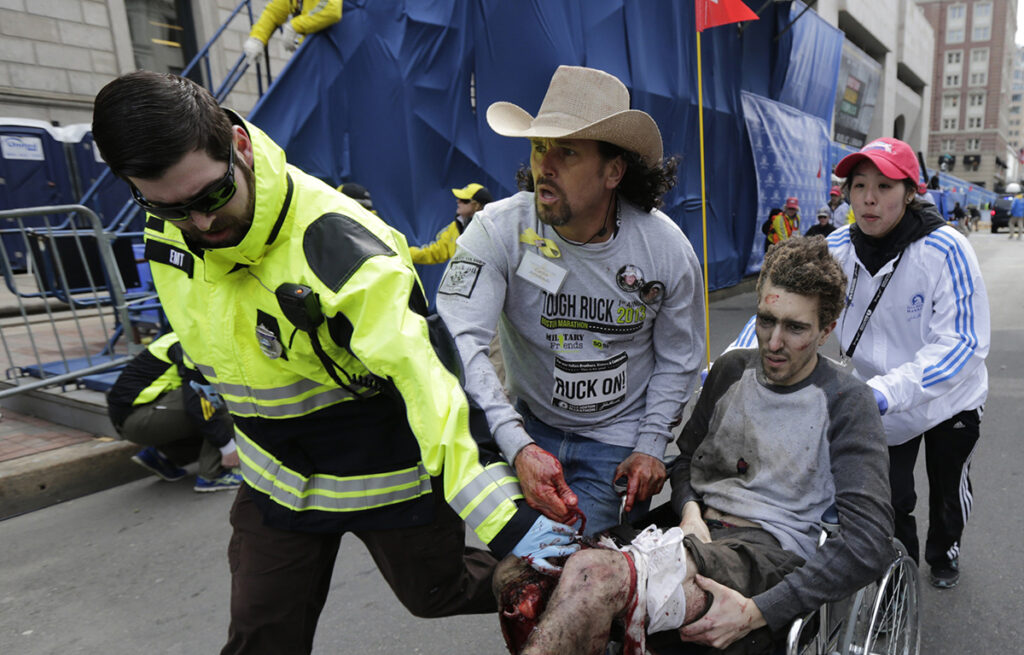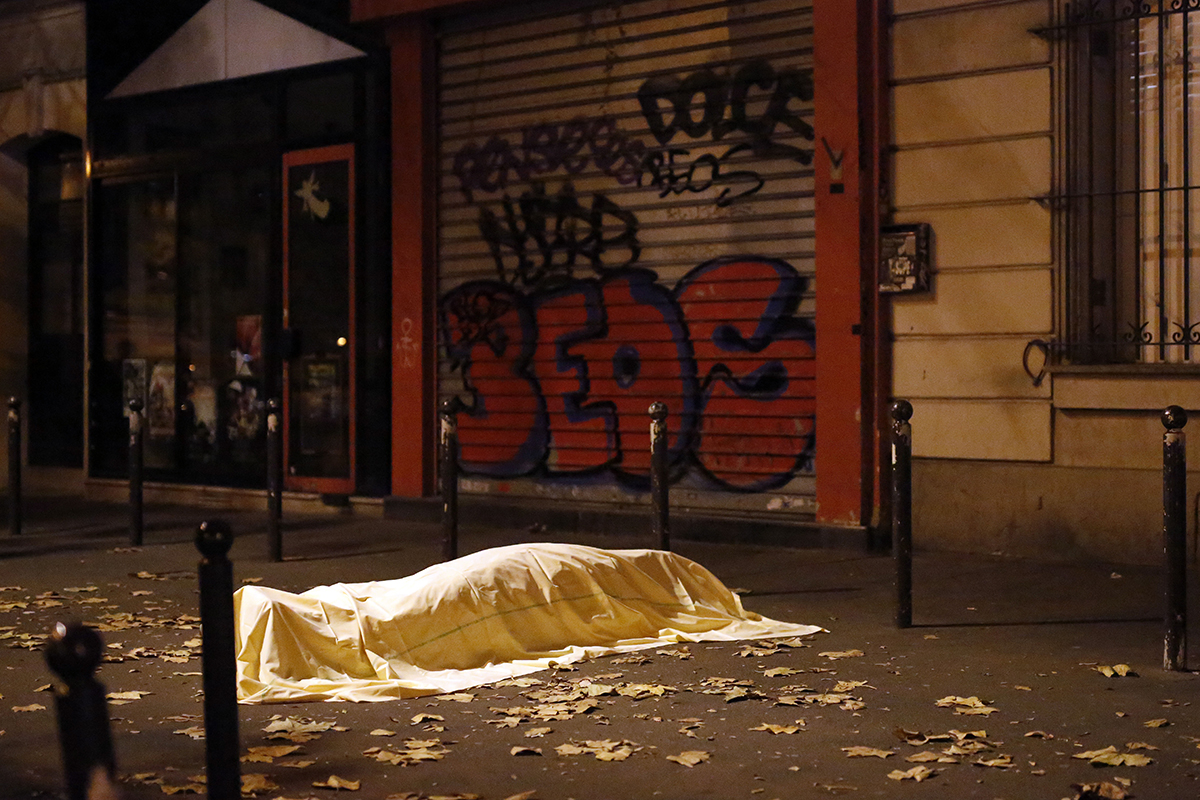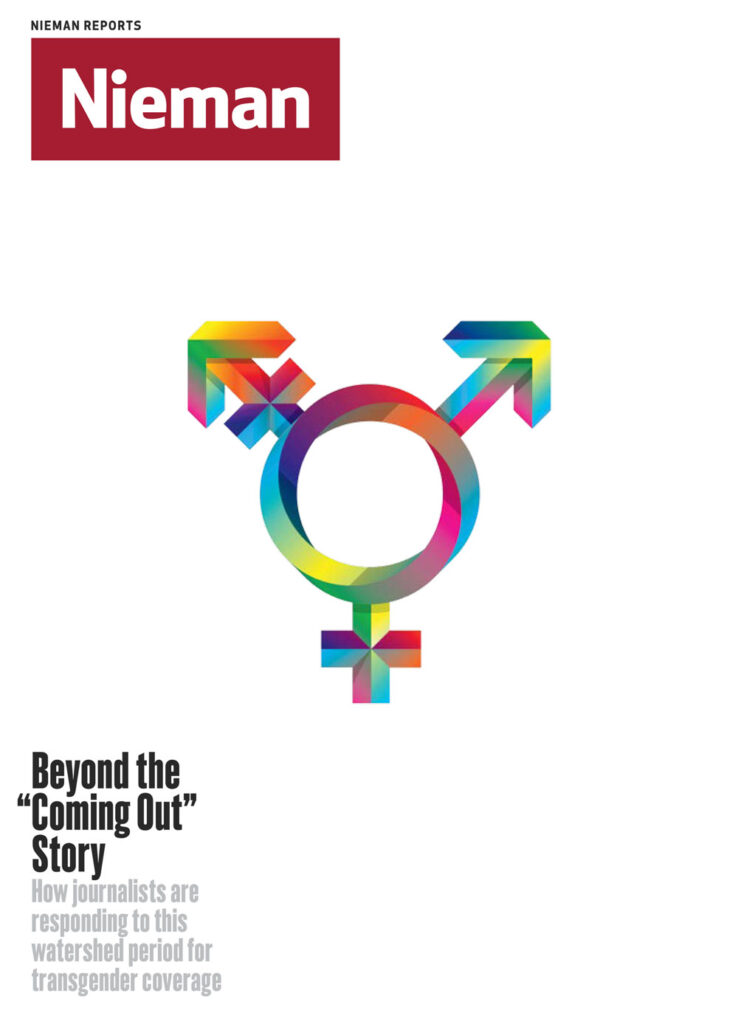There was no blood, no violence, no panic. Just a little boy’s body washed ashore, one of thousands of victims of the refugee crisis unfolding along the borders of Europe. Yet the images of Alan Kurdi lying on a beach at Bodrum, Turkey, published in September, provoked fierce debate in newsrooms and on social media about whether the sight of a dead toddler was too distressing to show—or too important to ignore.

Several frames were available. Some showed Kurdi’s body face down on the beach; others showed a policeman cradling the boy in his arms. In France, Libération was criticized for not printing the photographs at all. In Germany, Bild received so many complaints for publishing a photo on its back page that it removed all images from its September 8 issue to make a point. “We must force ourselves to look,” wrote Julian Reichelt, editor in chief of bild.de. “Without pictures the world would be more ignorant, the needy even more invisible, more lost. … Photographs are the screams of the world.”
Liz Sly, Beirut bureau chief for The Washington Post, tweeted one of the photos—and was surprised by criticisms that she was violating Kurdi’s dignity. “That puzzled me because I spend every day looking at these images of death,” she says, “and anyone in the region does, anyone who covers Syria—at least half a dozen pictures of dead children every day. Perhaps we’re violating their dignity by not publicizing them and having them die in silence in the dark.”
With the ongoing conflict in Syria and Iraq, frequent mass shootings in the U.S., and terrorist incidents such as the massacre in Paris, newsrooms are faced with constant decisions over the use of graphic or distressing images. What rules, if any, should news organizations follow when deciding whether to publish such images? Has the easy availability of graphic content on social media numbed audiences to tragedy? What effect does the production and consumption of such images have on journalists, editors, and their audiences? And does publishing emotive pictures like that of Alan Kurdi risk tipping stories from reportage into advocacy?
Yet the discussion is also familiar. Many of the most iconic news images of the last 100 years—a 9-year-old girl fleeing a napalm attack in Vietnam; the burned Iraqi soldier who died climbing from a car in the first Gulf War; Richard Drew’s “Falling Man” who jumped from a World Trade Center tower on 9/11; the dead passengers of the downed Malaysian Airlines plane in Ukraine—have been accompanied by debates about the ethics of their publication. Part of their power stems precisely from the fact that they show moments of pain and death usually hidden from view. It’s difficult to look at these images, and difficult to look away.

Photographers, of course, are on the front line of determinations about when, how, or whether to take these kinds of pictures. Gary Knight, co-founder of the VII Photo Agency, makes a distinction between taking distressing photographs and distributing them. Capturing an image and publishing it are separate decisions, he argues: “If you’re performing that role as a photographer or journalist, as some sort of witness or commentator, I think you need to record those things. But I don’t think that they need to be published.” Once the photograph is taken, Knight believes, a consultation needs to begin between the photographer and the editors. For Knight, the way an image is framed and publicized is just as important as the content of the image itself.
Perhaps the most persistent questions about how images of violence and death are framed are whether they dehumanize their subjects and whether they prioritize the suffering of certain groups over that of others. Michael Shaw, a California-based clinical psychologist and founder of the Reading The Pictures blog, calls this the dilemma of “the Western gaze”—a process by which deaths and disasters are unconsciously split into those that matter more and those that matter less.
In the wake of the November 13 terror attacks on Paris, social media users questioned why a bombing in Beirut on November 12 (which killed 43 people) did not receive the same level of media attention. “When my people died, no country bothered to light up its landmarks in the colors of their flag,” Elie Fares, a Lebanese doctor, wrote on his blog stateofmind13.com. “Their death was but an irrelevant fleck along the international news cycle, something that happens in those parts of the world.”
“Photographs are the screams of the world”
Alexey Furman, a Ukrainian photojournalist now studying for a master’s degree at the University of Missouri’s School of Journalism, felt a similar dynamic while covering the Euromaidan uprising and subsequent Russian annexation of the Crimea in 2014. He felt uneasy seeing American colleagues taking photographs of dead Ukrainian fighters. “As a photographer, I didn’t like or dislike [the photographs]. But as a citizen, there was a storm happening inside me … It was painful to see my people dead and just corpses there in the middle of a field, [photos] being taken by anyone.”
Rhonda Shearer, who runs iMediaEthics, a nonprofit site that investigates media ethics, says her organization’s investigation into images of the 2007 assassination of Pakistan leader Benazir Bhutto suggests Western media do treat dead Westerners differently. Many U.S. news outlets, including The New York Times, printed photographs from the Bhutto killing showing piles of dismembered corpses alongside a man wearing a brown jacket who was crying and gesturing. Although “Brown Jacket Man” was on the scene for more than an hour, iMediaEthics found that none of the Western journalists present discovered his name or if he was, as the captions later suggested, a “Bhutto supporter.” “If you transpose that onto an American scene,” Shearer says, “that would just never happen.”
In response to the iMediaEthics report, a photographer contacted Shearer to contest that assertion, pointing to the photographs of 9/11. But Shearer contends that very few images of dead Americans were published after that tragedy, the most graphic image in the mainstream media being Todd Maisel’s New York Daily News photograph of a severed hand. Images of people jumping from the twin towers were also rarely published in the U.S., and “people jumping,” Shearer says, “that’s clean shots compared with what I’m sure photographers have, which are the smashed bodies at the bottom of the World Trade Center, which is more what we saw in the Bhutto killing.”
Some argue that the cumulative effect of these editorial decisions is to perpetuate Western exceptionalism. Cultural critic David Shields, who analyzed about 1,000 front-page images of war from The New York Times for his book “War Is Beautiful,” says that “photo editors are looking for photos that reify received notions about war and battle and heroism and masculinity. It’s hard to resist the interpretation that this is the distribution of ideology by other means.” He points to recurring tropes—children juxtaposed with friendly, father-like soldiers or iterations of the Pietà from Christian art. “There is an ancient tradition of brutal and more truth-telling war photography,” Shields says. “If you only read The New York Times, you’d think war is heaven or, at worst, war is heck.”

In 2010, Time published an arresting cover image: Aisha, an Afghan teenager who had her nose and ears cut off by the Taliban. Kira Pollack, Time’s director of photography, explains that one of the considerations staffers took into account when debating whether to use the image was the effect on Aisha of becoming “iconic,” particularly since she still lived in Afghanistan at the time. “There are all these other things that go into these discussions,” Pollack says. “What happens when children see these pictures? That’s a conversation that we have at Time as well, because our audience is our families.”
The magazine published Aisha’s picture on the cover, with a provocative headline: “What Happens If We Leave Afghanistan.” For some, that wording tipped the piece into advocacy. The picture and headline became an argument for continuing American military involvement in the region.
The Kurdi pictures also made a polemical point, even if an uncontroversial one: a call to action in the face of Europe’s refugee crisis. Many who defended publication of the images cited this moral imperative. Knight is unconvinced. “I’ve been making pictures like that all my life, and very rarely did any of them make a difference,” he says. When the European Journalism Observatory looked at pre- and post-Kurdi coverage of immigration in three newspapers in each of eight European countries, it saw that “positive humanitarian stories about migrants” rose after the photos ran, but within about a week had decreased to pre-Kurdi levels. However, a study by the Visual Social Media Lab, backed by Google, found that social media users did change their language after the picture was published—the majority switched from using “migrant” to “refugee,” and this effect persisted for at least two months.
The Post’s Sly sees the reaction to the Kurdi picture as an argument for the publication of more distressing images, not fewer. She’s disappointed that the “Caesar” images—which were smuggled out of Syria by a military policeman code-named Caesar, and which allegedly show torture victims of the Assad regime—were not published widely. “I’m not sure it helps you to understand how intrusive this war is if you’re not seeing how violent it is and you’re not sharing that sense of horror and outrage that the people in the region are,” Sly says.
Many journalists working in the Middle East, where images of death and violence are more common on TV and in other media, echo the point. “In places like Latin America and the Middle East, people are more open to seeing images of suffering,” says photographer Andrea Bruce, who has worked in Iraq and Afghanistan. “It’s not labeled as an intrusion but more often proof of a wrongdoing by a government or military.”

While some experience being photographed as a violation, others see it as a validation—a crucial recognition of a wrong. In Ukraine, Furman recalls arriving in the village of Mykolaivka during fighting with pro-Russian separatists. An angry crowd that believed the Ukrainian government was responsible for shelling the village confronted him. A man grabbed him and took him to a bombed apartment building where a body lay in the rubble. “The community wanted me to get this picture out,” Furman says. “They wanted the world to know that this is what happened in their small town that no one ever talked about in international coverage.”
Jeff Bauman, who lost his legs in the Boston Marathon bombings in 2013, made a similar point in The Guardian last year. Charles Krupa, the Associated Press photographer who took pictures of Bauman and his injuries as he was being rushed from the scene in a wheelchair, apologized for doing so. “I told Charlie that I understand now, like I didn’t then, that he was helping us that day, in the best way he knew how,” Bauman wrote. “He was showing the world the truth—that bombs tear flesh and smash bones—and making the tragedy real.”
The publication of graphic images from Syria has become particularly vexed as so few journalists are working in the region. Most of the images from the country are taken by activists and can be hard to verify and interpret. Others are straightforward propaganda from jihadist groups. ISIS (Islamic State in Iraq and Syria) fighters film many of their killings in high definition, adding logos and graphics and distributing them through their online magazine, Dabiq, Twitter, and other social media.
ISIS videos follow an approach also used by the Taliban, which once banned photography but now has its own video production unit, and Hezbollah in Lebanon, which runs its own TV station. Images of atrocities—and of civilians killed by Western military action—are key tools of propaganda and recruitment, according to Susie Linfield, a professor at New York University’s Arthur L. Carter Journalism Institute and author of “The Cruel Radiance: Photography and Political Violence.” The images can be especially effective because they are often broadcast to people who are illiterate, Linfield says, “who have no access to newspapers, so this is their main source of information, this constant flood of atrocity images.”
The ubiquity of graphic images has lent fresh impetus to worries that disturbing photographs undermine public support for military actions carried out in their name. Canadian photographer Paul Watson’s images of a dead American soldier being dragged through the streets of Mogadishu in 1993 catalyzed President Bill Clinton’s decision to pull U.S. peacekeeping troops out of the country the next year. Osama bin Laden later said the unwillingness of the U.S. to tolerate military casualties demonstrated “[its] impotence and weaknesses.”
Discussions of the effects of graphic images tend to focus on those upset or offended by them and less so on those who might like them too much. In the wake of repeated mass shootings in the U.S., some journalists have expressed concern that media coverage could be exacerbating the phenomenon. A week before the Kurdi pictures began to circulate, social media was also the place where many saw the fatal shooting of Virginia news reporter Alison Parker and camera operator Adam Ward by a disgruntled former colleague. The shooting happened during a live television broadcast and was also filmed by the shooter himself, who was holding a camera just above his gun. Soon after the killings, he uploaded the footage to Twitter and Facebook. Both social networks had an auto-play feature, meaning that thousands of users ended up watching a snuff video without choosing to or having any warning about the content. Both social networks quickly deactivated the shooter’s accounts. The next day, stills from both Ward and the shooter’s videos appeared on front pages. In Britain, the tabloid The Sun used a frame that showed the moment he fired, the muzzle flash from the gun visible.
Linfield argues these images should not have been published. In October, Mother Jones published a cover story about efforts to stop the mass shootings. In a related article online, national affairs editor Mark Follman reflected on how news coverage of such incidents affected vulnerable young men, arguing that sensationalist reporting was both encouraging would-be killers to act and to make their crimes more spectacular. “Forensic psychologists have come to understand, by interviewing these people—the ones who survive—they know they are very aware of the media attention they will get,” Follman says. “It’s what they want. It’s a certain responsibility that the media has now that we know that, not to engage with that any more than we need to in order to report forensically for the public interest.”
Follman argues that media organizations need to make sure that photographs they publish of such killers and their crimes do not contribute to their self-mythologization. He contends that, in the case of the man who shot U.S. Representative Gabrielle Giffords and others in Tucson in 2011, it would be better to use a neutral yearbook photograph rather than the mug shot that was seized on by the press. “There’s an argument to be made not only that it’s not necessary, but it’s potentially damaging the people who emulate [him],” Follman says. “They see that this guy is memorialized with this deranged, smug grin on his face.” Similarly, he suggests journalists think carefully before using images of the gunman who killed nine people in a church in Charleston, South Carolina, waving a Confederate flag and wearing white nationalist symbols, taken from his social media profiles. Some argue we should go even further: following a shooting in Roseburg, Oregon that left 10 dead, including the gunman, Douglas County Sheriff John Hanlin refused to name the perpetrator when briefing the media. “I will not give him the credit he probably sought prior to this horrific and cowardly act,” he told reporters. Several media organizations have followed suit, with The Washington Post publishing on December 5 a long read about one of the Roseburg survivors without once mentioning the gunman’s name.
The lack of context on social media adds a new wrinkle to the debate about publishing graphic photographs
The use of graphic images should prompt many questions in a responsible newsroom. Is the image’s news value or public interest greater than the potential negative impact on the subject? Does it bolster an existing narrative about a conflict? If so, does it do so consciously and fairly? Does it dehumanize its subjects or draw the world’s attention to their plight? Could the image be used as propaganda or drive a vulnerable person to commit a crime? If so, is it still essential to the story and therefore should it be published anyway?
There are no easy answers to these questions, and even highly ethical, conscientious journalists will disagree over particular cases. Bradley Secker, who has worked in Iraq, Syria, and Greece and been published in outlets including The Independent, The New Republic, and The National in the United Arab Emirates, believes news organizations can address these concerns in part by giving audiences as much context as possible alongside the photographs. “As long as the image captions are accurate and the image itself hasn’t been manipulated, there is little room for propaganda,” Secker says.
Reading The Pictures’s Shaw cites the Pulitzer-winning work of Craig F. Walker, who spent a year photographing an Iraq War veteran for The Denver Post and accompanied the images with extended captions. This is a way not just to mitigate the reductive nature of photos, Shaw argues, but to create a richer, more nuanced form of storytelling. In contrast, he criticizes website photo galleries because they strip away context.
Social media complicates the equation even further. Should a graphic image be appended to a tweet, when there is so little opportunity to provide context? Should social media companies disable auto-play for videos to avoid inadvertently displaying snuff videos in people’s timelines?
For Time’s Pollack, discussions about graphic or distressing images matter because those images often resonate most with audiences. Jerome Sessini’s haunting pictures of the dead passengers of MH17, a plane shot down over Ukraine, were the most viewed on Time’s Lightbox section last year, attracting nearly 12 million pageviews and 900,000 unique visitors.
The appeal of Sessini’s photographs highlights an uncomfortable truth: For all the outcry, there is clearly an audience for these kinds of images. As a photographer, Gary Knight argues that audiences need to ask themselves their motivations for viewing such images, just as the media must interrogate its reasons for publishing them.
Knight tells the story of returning to London from an assignment in Bosnia in 1997 and being asked by Newsweek to cover the aftermath of Princess Diana’s death, which was initially blamed on paparazzi pursuing her car through Paris. Outside Buckingham Palace, “I got a lot of grief from the public for being a photographer,” he recalls. “I was blamed, collectively, for killing Princes Diana. And I thought, these are the women who are buying the Sun and the Mirror and the Mail, and all these newspapers that were hounding Princess Diana.”
Barbie Zelizer, professor of communication at the University of Pennsylvania and author of “About to Die: How News Images Move the Public,” suggests that, despite new technologies that make graphic images easier to capture and share, the controversy hasn’t changed much over the years. “The images we are getting, and the debates which greet them, are very much the same as they’ve always been,” she says. She offers a simple, though far from infallible, test in deciding whether to publish. Is the photo central to the story? If the story cannot be told without it, the image must be published, no matter how distressing it might be, she argues.
Alexey Furman believes that graphic images only work if they make the reader want to know more about them, rather than instantly turn the page. “We have to produce images that the world will be ready to spend some time with, and read the captions, and look again, and observe.”




